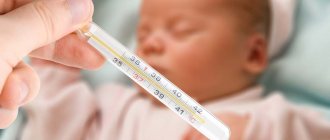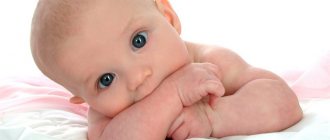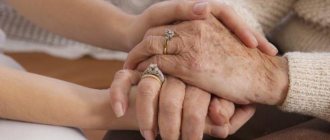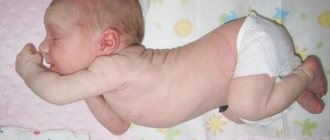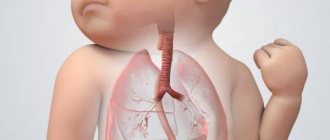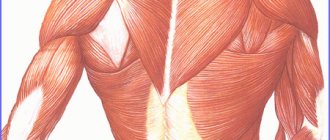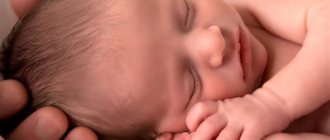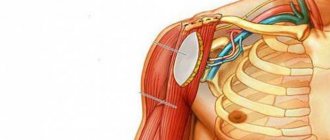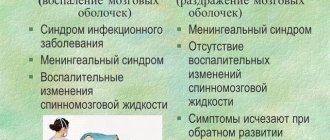What diseases can tremor be a symptom of?
The location where the trembling occurs may be an indirect indication of the cause of the disorder.
For example, lips often tremble in premature babies, as a result of insufficiently formed nervous processes. In general, trembling of the lips and chin, if it occurs with excitement, crying, fear, in children under four months, is considered normal. In this case, the chin and lips tremble from tension or emotional stress that has overexcited the nervous system. However, if this occurs in the absence of crying or excitement, then it is possible that the newborn is subject to excessive muscle tension - “muscle hypertonicity.”
Tremor of the arms and legs in newborns is evidence of excessive release of norepinephrine by the adrenal glands. This is how an excessively strong reaction to various stress factors manifests itself. The lower limbs tremble much less frequently than the arms. The history of such babies often includes prematurity, birth trauma, and cerebral hypoxia.
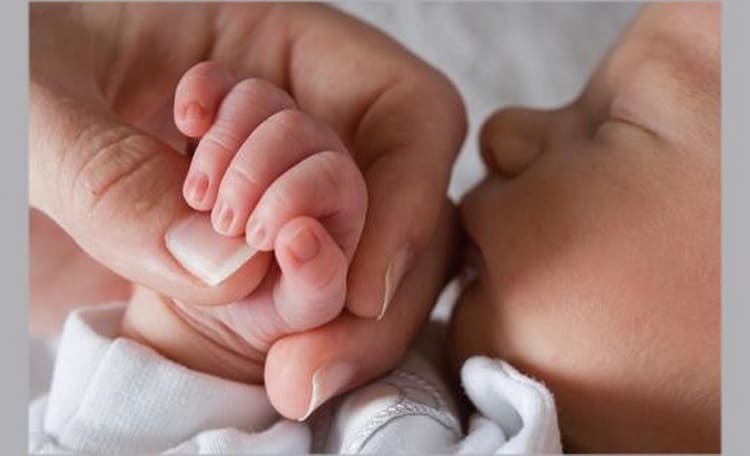
If the limbs tremble, consultation with a pediatrician and neurologist is necessary, as parents may confuse tremor with seizures. Convulsive muscle contractions, in contrast to physiological tremors, are a sign of serious developmental pathologies.
Head trembling, if it is not caused by hunger, discomfort or emotional stress, is an alarming symptom. Especially if such manifestations have not decreased by the age of three months. This may be a sign of a dysfunctional state of the endocrine or nervous systems.
The arms, head and chin may tremble if you have the following health problems:
- increased intracranial pressure;
- with magnesium deficiency in the body - hypomagnesemia, neuromuscular excitability increases, spasms, cramps and tremors appear in the muscles;
- provokes the problem of hypocalcemia (lack of calcium) due to insufficient external supply of this trace element with milk;
- in case of malabsorption in the intestines, with stool disorders;
- elevated blood sugar levels – hyperglycemia;
- brain damage;
- infectious diseases;
- traumatic brain injury.
Treat or wait
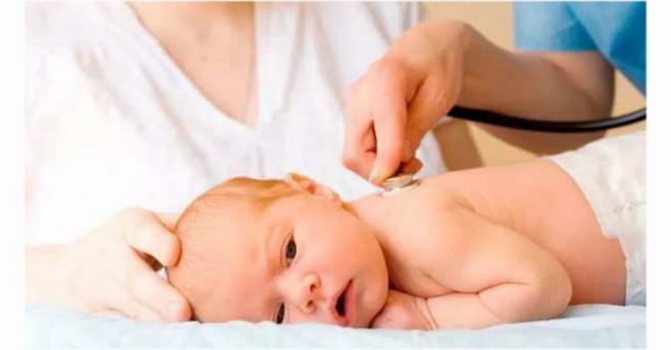
Excessive tension and slight trembling indicate increased excitability of the baby and insufficiently formed self-regulation of the nervous system. Despite the fact that trembling is considered normal for newborns, it is necessary to report it to your pediatrician.
Important! A pathology that must be treated is considered to be trembling of the limbs in an infant after the age of four months.
Treatment is also necessary if the newborn shakes his hands regardless of the situation, and over time this shaking only intensifies; if trembling of the limbs is accompanied by tremors of the head and lower lip of the infant.
Seek medical help if you have one or more of the following signs:
- trembling covers the limbs, face and head, there is a feeling that the newborn is shaking all over;
- shaking lasts longer than 30 seconds;
- asymmetrical twitching (chin and one leg or one arm);
- during an attack, the skin turns pale to blue, the baby becomes covered in perspiration;
- the child turned 4-5 months old, and the trembling did not stop.
In all these cases, parents need to contact a pediatric neurologist who will prescribe comprehensive treatment. Therapeutic procedures include special gymnastics, massage, exercises in water, and medication.
The body of a newborn is a very plastic system; with proper and timely treatment, many of its functions are restored and return to normal. If you follow all medical recommendations, then in the absence of serious pathologies, the baby’s nervous system will strengthen and the twitching will disappear. Physiological tremor in newborns is easy to treat. If you let everything take its course, then in the future, headaches, problems with posture, fatigue and other health problems are quite possible.
Doctors' recommendations

Tremor in newborns, although a variant of the norm, still worries parents. And although this is not a pathology, but a temporary physiological condition, such a baby requires the right approach.
General recommendations from doctors will be as follows:
- To exclude pathologies and for your own peace of mind, be sure to discuss the involuntary movements of the newborn with your pediatrician. If, in addition to the chin, the limbs and head are trembling, then the advice of a pediatric neurologist is absolutely necessary. In any case, a planned examination by this specialist should take place during the “critical” periods: in the third, sixth and ninth months of life. These are moments of special vulnerability for the baby’s nervous system.
- Minimize or eliminate situations in which the newborn experiences any discomfort. Create a calm atmosphere in your home, eliminate stress factors (sharp sounds, screams, bright lights, many visitors).
- The newborn should receive a relaxing massage twice a day.
- Two or three times a week, bathe your child in warm baths with soothing herbal infusions (mint, lemon balm, oregano, valerian).
- Almost constant and calm physical contact with the mother is important, especially when the baby falls asleep or eats.
- Following a routine for your newborn creates predictability and helps you adjust more quickly to the transition from one activity to another.
- Twice daily walks in the fresh air are also required to saturate the newborn’s tissues and organs with oxygen.
Compliance with such simple therapeutic measures stabilizes and improves self-regulation processes in the newborn’s body. In some cases, the doctor may prescribe pharmacological agents. The action of the drugs is aimed at relaxing and optimizing oxygen access to all body systems.
Swimming and gymnastics
If you have not yet decided to send your baby to infant swimming, then you can carry out water procedures at home. If a child has tremors of the limbs, then it will be extremely useful for him to swim, even while in your arms. Let the baby have plenty of play with his hands and feet, and let the water in the bathroom be at the most comfortable temperature.
Gymnastics for a baby is also useful. There are a number of exercises that you can also do with your baby at home.
- Grab your baby's foot with one hand and tap the outside of his leg with the other. This exercise is called the “hammer” and is repeated on both legs alternately.
- Stroke your baby's arms and legs. Take the baby by the hand and, shaking it slightly, lower yourself from the shoulder to the wrist. This exercise should be performed on the legs and arms alternately.
- Stretch your baby's buttocks. To do this, place the baby on his tummy and just lightly tap his butt with your little fists.
Remember that tremors are a completely natural phenomenon and should not cause you to panic. But you must monitor your baby daily. Children under one year old continue to develop, so you need to not miss the moment when you, together with a specialist, can make any adjustments. Doctors note several critical periods in a baby’s life.
Newborn tremor
Recently I encountered: the little one began to shake his leg and his chin shakes, especially after and while crying (when he is very nervous). I decided to share some useful information:
Tremor in newborns (up to 1 month) is twitching of the chin, arms, and less often, legs. Along with muscle hypertonicity, tremor is a sign of increased excitability of the child and the immaturity of his nervous system. These periodic muscle contractions are observed in approximately half of newborns - usually in an excited state: with severe crying, fear; or during REM sleep (when a sleeping baby's eyes move frequently). In the first weeks of life they are a variant of the norm. In any case, if you observe tremor in a child, you need to tell your pediatrician about it. What is newborn tremor? Tremor during crying is a compensatory excitation of the peripheral nervous system to stabilize the condition. Small in amplitude and frequent in intensity tremor during crying in a newborn baby is a physiological feature of his nervous system. How long is it normal for newborns to have tremors? In the first few days of life, small and frequent tremors are quite natural - this is how the excited state of the child’s nervous system is not yet strengthened. In most children, rarer contractions with a wide amplitude last no more than a week. In the future, they are possible when the baby screams or gets excited, when he feels hungry and during the REM sleep phase, and by three months they should completely go away. What is the cause of tremor? This condition occurs in infants due to the immaturity of the nerve centers of the brain, as well as due to the high content of norepinephrine (the adrenal brain hormone responsible for the transmission of nerve impulses) in their blood. Therefore, premature babies more often suffer from tremors of the limbs, chin, lips - after all, they are almost always born with an undeveloped central and peripheral nervous system. In general, any factors that disrupt the normal development of the nervous system of the fetus and newborn can cause tremor. For example, fetal hypoxia during pregnancy or childbirth, leading to serious disturbances in the functioning of the brain and central nervous system; birth injuries; stress in the mother during pregnancy (especially in the last weeks), when an excess of norepinephrine in her blood can have a destabilizing effect on the child’s endocrine and central nervous system. What diseases can tremor be a symptom of?
If the manifestations of tremor are intense, they affect not only the arms and chin, but also the legs and head; are not associated with arousal or hunger and do not subside over the course of weeks or even months - this is an alarming sign. It can occur due to very serious problems: hypoxic-ischemic encephalopathy, drug withdrawal syndrome, hyperglycemia, hypocalcemia, hypomagnesemia, sepsis and even intracranial hemorrhage. Do tremors need to be treated?
If tremors occur only when crying or frightened, as well as during REM sleep, then parents should not worry. If the tremor is causeless and especially if it intensifies, then this may indicate neurological disorders. In such cases, it is better not to hesitate and contact a pediatric neurologist. As a rule, for children prone to tremors, the doctor prescribes special gymnastics, a special therapeutic relaxing massage, and swimming in the pool.
Massage for infants: useful tips Pediatricians advise starting to massage a newborn after he is 5-6 weeks old. You need to master just a few basic massage movements that your pediatrician will teach you: - kneading; — vibration; - stroking; - rubbing. Remember an important rule - all movements must be carried out along the joints, that is, from the periphery to the center. “Before you start massaging your baby, you need to prepare the room. To begin, ventilate the room for twenty to thirty minutes. If it's warm outside, you can leave the window open. “You will have to forget about long nails for some period; they need to be cut short. Don't forget to remove rings and bracelets from your hands - your baby's skin is delicate and you could accidentally scratch him. Before starting the massage, shake your hands several times and then rub your palms together. Massage must be done with dry and warm hands. » For a massage session, choose a time when the baby is awake and in a good mood. During the massage, observe the child’s reaction; as soon as he begins to show his dissatisfaction, stop. » It is necessary to perform a massage in a place familiar to the baby - for example, on a changing table. » Make sure the baby is comfortable and the sun is not shining in his eyes. “Don’t forget to communicate with your child during the massage: smile, talk to him, sing songs. Remember that massage is not only physical contact with the baby, but also psychological. » Baby massage should begin and end with stroking. » When you massage your baby, do not use powder or aromatic oils. The fact is that they can clog children's delicate pores. Regular products used daily to moisturize your baby's skin are quite sufficient. » Doctors recommend doing a relaxing massage before daily water treatments. The effect will be especially noticeable for the baby’s nervous system.
Soothing massage before bed The technique of massaging a newborn before bed is not at all complicated; any young mother can easily master it. Remember that your movements should be smooth. Start the massage with the baby's face, stroke his eyebrows and the wings of his nose, and then move on to the main exercises. 1. Exercise “Hammer” Place the baby on his back on the changing table, clasp the right foot with one hand, and tap the outside of the leg from bottom to top with the fist of the other. Repeat the same exercise with the left leg. 2. Exercise “Stroking Hands” Fix the baby’s hand with your left hand, and gently clasp his shoulder with your right hand. Using shaking movements, gradually work your way down to the wrist. Repeat 2-3 times and move to the other hand. 3. Exercise “Clock” Gently stroke the baby’s tummy with your entire palm in a clockwise direction for 5-7 minutes. This technique is especially recommended for children who have intestinal problems. 4. Muscle relaxation exercise Hold the baby's foot with one hand, and grab the bottom of the leg with the other. Using shaking movements, move all the muscles in the direction from the hip to the heel. 5. Exercise “Stomping” Place the baby on his tummy and knead his buttocks with your fists. It is advisable to place some bright toy in front of the baby before this exercise to engage the muscles of the back and neck. 6. Exercise “Herringbone” Use your palms to stroke the child’s back in the direction from the back to the tailbone and “herringbone” in relation to the spine. Video with massage and bathing:
Massage
Massage is one of the key therapeutic techniques aimed at reducing muscle contractions, relaxing and strengthening the nervous system of newborns. Its effectiveness has been proven for both physiological and pathological types of tremor.
Find out how to choose baby cream and petroleum jelly for newborns.
Recommendations
It is best to take several lessons in infant massage from a competent specialist before starting home sessions. General recommendations for parents:
- massage can be performed starting from 1.5 months of age;
- Before the session, you need to ventilate the room for 30 minutes, but it must be at a comfortable temperature for the baby;
- it is necessary to remove jewelry, wash and dry your hands, heat them by rubbing against each other;
- nails should be short;
- perform very careful, soft, smooth movements. Do not apply rough or sharp pressure under any circumstances;
- it is most effective to conduct a session before swimming;
- The duration of the session is 10-20 minutes;
- You need to massage every day.
Important! The emotional mood of the baby and mother plays an important role. The baby should be cheerful, cheerful, and not worried about anything. The mother, in turn, should support the baby with affectionate intonation, a smile, friendly facial expressions, and singing.
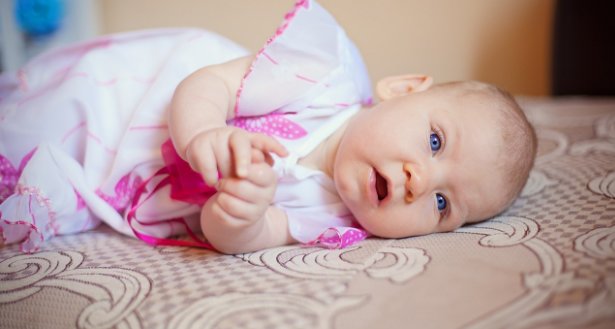
For a child, tactile sensations are a powerful tool for communicating with their mother; they strengthen the connection between them, stimulate the development of intelligence, calm, increase blood circulation and oxygen saturation of cells. Since the other senses of a newborn are less developed than the skin, massage can have a strong impact on the baby.
Movements
When performing massage on newborns, several basic types of movements are used:
- stroke;
- knead;
- rub;
- shake.
The massage should be performed using only the fingertips, but not the entire palm, otherwise the effectiveness of the procedure will be reduced. It is also necessary to avoid the area of large joints (shoulder, hip, knee), massaging the periphery area.
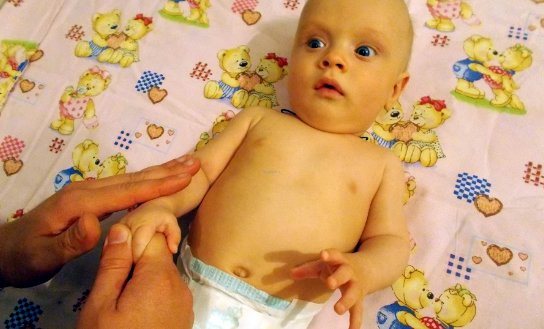
Subsequence
You need to start with the face. Using your fingertips you can outline the lines of the eyebrows, nose, chin and lips. Using your thumb and forefinger can rub your earlobes a little more effectively. Next they go down to the chest. Again, use your fingertips to outline the lines of the ribs, while avoiding the area of the mammary (breast) glands.
To work the chest, you need to spread it apart several times and then cross the baby’s arms over the chest. You can massage your tummy just behind your chest. To do this, you need to make gentle movements with your fingers in a clockwise direction. Then the baby is placed on his stomach and the back is kneaded. It is very important to avoid touching the spine! You need to stroke the back with your fingers from top to bottom, and use the back of your hand from the buttocks to the head.
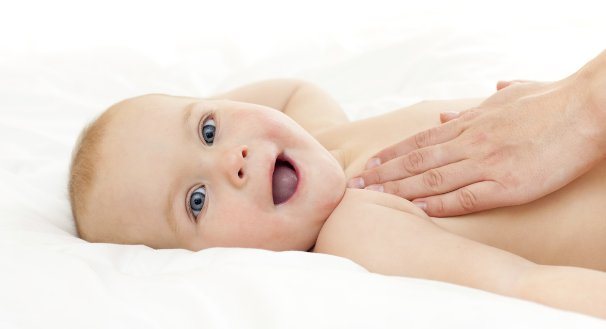
You can also make movements from the spine to the ribs. Finally, massage the legs and arms - the principle is the same for these areas. You can start from the feet; to knead, you need to make spiral movements with your thumb from the center of the foot to the edges. Then you need to take the baby’s leg completely in your palm like a ring, and make upward movements from the feet to the hips. Massage of palms and arms is carried out in a similar way.
Tremor in newborns
Tremors in newborns are various types of muscle twitching that are observed in children from birth. Most often they talk about tremor of the limbs or chin. There may also be a head tremor - but this is already a sign of quite serious neurological problems, and trembling of the hands or chin when screaming or crying for up to three months is not considered a pathology. Tremor in newborns occurs due to the immaturity of the nerve centers responsible for movement in the brain and the excess content of norepinephrine in the child’s blood during manifestations of emotions. And this excess occurs, again, due to the immaturity of the adrenal medulla, which produces norepinephrine. There are so-called critical periods in the development of the nervous system of a child in the first year of life, during which it is most vulnerable to some kind of disruption in normal development. These are the first, third, ninth and twelfth months of a child’s life - it is during these periods that it is advisable to visit a pediatric neurologist. If attacks of “trembling” remain longer, and they can be observed both a year and later, it means that there is or was damage to the child’s nervous system - during pregnancy or childbirth. There can be many reasons for this - even the mother’s stress during pregnancy matters, because the same norepinephrine often went off scale in her blood, only this was expressed not in muscle twitching, but in other emotional reactions. And the baby experienced the same flood of hormones, which could lead to an imbalance of both the central nervous and endocrine systems. Fetal hypoxia during pregnancy and during childbirth, and there are many reasons for it, also contributes to disturbances in brain activity. Hypoxia can also occur with placental dysfunction, with bleeding and threatened miscarriage, with polyhydramnios and intrauterine infections. During childbirth there may be weakness of labor and rapid labor, entanglement of the umbilical cord and placental abruption - there are many options. All of them lead to disruption of the supply of oxygen to the brain and subsequently manifest themselves as tremor in newborns. Premature babies often suffer from tremors of the limbs, chin, and lips, since their central and peripheral nervous systems are initially immature, and maturation outside the mother’s body, even with excellent and proper care, is not quite the same. Therefore, tremor in newborns, although it is considered not to require correction up to three months, should lead parents to the idea that the child has such a “weak link” and it requires close monitoring. The nervous system of a newborn is a very malleable and dynamic formation, and with proper and timely treatment, it is perfectly restored, returns to normal, strengthens - and after some time the baby can be completely healthy. In addition to observing a pediatric neurologist and following his instructions, a baby prone to tremors must be given a relaxing massage and therapeutic exercises, which should be carried out at least in the first year of life by an experienced specialist, early swimming in a special pool, a calm, even and friendly environment in the family. .
The baby's leg is trembling, what could it be?
Tremor in newborns (up to 1 month) is twitching of the chin, arms, and less often, legs. Along with muscle hypertonicity, tremor is a sign of increased excitability of the child and the immaturity of his nervous system. These periodic muscle contractions are observed in approximately half of newborns - usually in an excited state: with severe crying, fear; or during REM sleep (when a sleeping baby's eyes move frequently). In the first weeks of life they are a variant of the norm. In any case, if you observe tremor in a child, you should tell your pediatrician about it. What is tremor in newborns? Tremor during crying is a compensatory excitation of the peripheral nervous system to stabilize the condition. Small in amplitude and frequent in intensity tremor during crying in a newborn baby is a physiological feature of his nervous system. How long is it normal for newborns to have tremors? In the first few days of life, small and frequent tremors are quite natural - this is how the excited state of the child’s nervous system is not yet strengthened. In most children, rarer contractions with a wide amplitude last no more than a week. In the future, they are possible when the baby screams or gets excited, when he feels hungry and during the REM sleep phase, and by three months they should completely go away. What is the cause of tremor? This condition occurs in infants due to the immaturity of the nerve centers of the brain, as well as due to the high content of norepinephrine (the adrenal brain hormone responsible for the transmission of nerve impulses) in their blood. Therefore, premature babies more often suffer from tremors of the limbs, chin, lips - after all, they are almost always born with an undeveloped central and peripheral nervous system. In general, any factors that disrupt the normal development of the nervous system of the fetus and newborn can cause tremor. For example, fetal hypoxia during pregnancy or childbirth, leading to serious disturbances in the functioning of the brain and central nervous system; birth injuries; mother’s stress during pregnancy (especially in the last weeks), when an excess of norepinephrine in her blood could have a destabilizing effect on the child’s endocrine and central nervous system. What diseases can tremor be a symptom of? If the manifestations of tremor are intense, they affect not only the arms and chin, but also the legs and head; not associated with arousal or hunger; and do not weaken for weeks or even more so months - this is an alarming sign. It can occur due to very serious problems: hypoxic-ischemic encephalopathy, drug withdrawal syndrome, hyperglycemia, hypocalcemia, hypomagnesemia, sepsis and even intracranial hemorrhage. Do tremors need to be treated? If tremors occur only when crying or frightened, as well as during REM sleep, then parents should not worry. If the tremor is causeless and especially if it intensifies, then this may indicate neurological disorders. In such cases, it is better not to hesitate and contact a pediatric neurologist. As a rule, for children prone to tremors, the doctor prescribes special gymnastics, specialized therapeutic relaxing massage, and swimming in the pool.
Signs to worry about and call your doctor
If a baby experiences chin tremor after 3-6 months, this may indicate a disorder of the nervous system. Here are some symptoms that may prompt you to see a doctor:
- tremor of the chin in an infant is observed at rest;
- trembling intensifies and lasts longer;
- trembling spreads throughout the head and limbs.
The causes of such disorders may be severe maternal stress during pregnancy, infections, postpartum injuries, hypoxia, rapid or too long labor.
If such symptoms are detected, you should immediately contact a specialist who, after conducting a diagnosis and examination, will be able to accurately determine the cause of chin tremor and prescribe treatment.
Tremor in a newborn baby
As a rule, until the age of three months, the baby’s nervous system is imperfect, as a result of which one can observe how his leg twitches, his arms shake, and when he cries, his chin, lower lip, and jaw often tremble. It should be immediately noted that if these symptoms quickly disappear after the baby has calmed down, then there is no reason to worry.
Head tremors may indicate certain neurological disorders that require appropriate treatment from a neurologist or neurologist.
Causes of tremor in infants:
- Physiological immaturity of the baby’s nervous system.
- Premature pregnancy.
- Complications during childbirth, such as rapid or prolonged labor.
- Complications that arose during pregnancy: uterine hypertonicity, fetal hypoxia, etc.
- The stress that a mother experiences while carrying a child, her experiences, her fears. All this can affect the baby’s vulnerable nervous system.
As a rule, treatment is not required if:
- Tremors of the arms, legs, and chin are observed in the baby until he reaches the age of three months.
- The chin trembles when the baby cries.
From parents' reviews
Olga, 27 years old, St. Petersburg, son Kolya, 1 year 2 months
When we encountered this problem, I was honestly shocked. And my husband generally suffered from a nervous tremor when he was left alone with his son and for the first time saw his chin shaking.
We went to the doctor, he sent me for tests and an ultrasound. Research showed that everything was fine, but of course it looked very creepy. Glad everything worked out!
Natalia, 25 years old, Yaroslavl, daughters Alina - 3 years old and Christina - 1 year 8 months
Both of my girls had chin tremors. A terrible sight! Both the first and second births were difficult, the youngest was born a little strangled.
We took a bunch of tests and I almost turned gray! But everything worked out fine, for the eldest it went away after a year, for the youngest it only lasted a week.
Tatyana, 30 years old, Anapa, daughter Georgina, 1 year 5 months
When I noticed that my baby’s chin was trembling, I almost went crazy! I took Gina to an ultrasound four times, the doctor prescribed pills for peace of mind and good sleep, to improve appetite, but nothing helped us.
But the doctors said that everything was fine with my daughter and that it would go away with time. I didn’t believe it, but after a year the trembling really went away.
What to do
As a rule, treatment of tremor in children under 3 months is not required, but it is necessary:
- Monitor the baby's condition.
- Analyze what factors cause the child’s hands, chin, lower lip, and jaw to shake.
- Determine the presence or absence of other complications in the baby’s well-being, for example, sleep disturbances, tearfulness, mild excitability, trembling of the limbs and body for no apparent reason, etc.
- Notify the treating pediatrician or family nurse that the baby’s arms or legs are trembling, and demand that the baby be examined by the appropriate specialists.
- Create an atmosphere of calm and goodwill in the house, since the psychological microclimate in the family significantly affects the health of children.
- Massages and warm baths will also be useful, provided that the baby accepts them with pleasure.
Treatment of tremor in infants is carried out by a neurologist. Only an experienced specialist can prescribe the necessary medications, monitor and, if necessary, adjust the baby’s treatment.
What is a tremor and when does it go away?
This term refers to systematic twitching of a child’s arms, legs, chin, and head. If this phenomenon is accompanied by an increase in tone in muscle tissue, we can conclude that the baby’s nervous system is not sufficiently formed and is highly excitable.
This condition occurs quite often - in approximately every second baby. Muscle contraction in most cases occurs during sleep or during strong arousal.
A baby’s head tremors may appear if the centers of the nerve endings that are located in his brain and are responsible for movements are underdeveloped. In addition, this is often facilitated by an increase in the hormone norepinephrine in the blood.
Tremors of the arms, legs, chin or lips often occur in premature babies. This is due to the fact that their nervous system has not had time to form, and maturation outside the mother's womb is still considered unnatural even with proper care.
Tremor in newborns does not need correction until three months, but parents must understand that the child has a problem that requires their close attention.
The baby’s nervous system is very dynamic and susceptible to external influences, and therefore, with adequate treatment, its condition is easily normalized and restored.
Consultation at Yusupov Hospital
You can get advice on the causes of tremor in a child from neurologists at the Yusupov Hospital. Experienced doctors, doctors and candidates of medical sciences work here, who perform high-quality diagnostics and treatment of various neurological diseases.
At the appointment, the doctor will perform a neurological examination, evaluate reflexes, and analyze development. If necessary, additional examination methods will be prescribed, which can be completed in the modern diagnostic center of the Yusupov Hospital. After the examination, the doctor will give recommendations for further action.
If the tremor in a newborn is not pathological, then it will be enough to give the child a massage, engage in physical therapy, swimming, take baths with soothing herbs, and breathe fresh air. Additionally, medications that improve oxygen supply to tissues may be prescribed.
In the case of a pathological nature of the tremor, appropriate treatment will be prescribed, which will include more serious measures: drug therapy, physical therapy. Treatment is prescribed strictly on an individual basis, depending on the condition of the little patient.
You can make an appointment with neurologists or undergo an examination at the diagnostic center by calling the Yusupov Hospital. The clinic accepts adult patients.
source
Causes of tremor
This condition can appear due to various reasons, the most common of which are:
- Immaturity of the nervous system.
During the first weeks after birth, the child’s nervous system cannot be fully responsible for the functions performed, which is the reason for the development of tremor. In most cases, twitching occurs due to the fact that the nerve centers located in the brain are not able to work correctly. Also, this condition can be caused by an excess of the hormone norepinephrine in the blood, which indicates that the nerve centers of the adrenal glands have not yet been fully formed. - Hypoxia.
This condition can occur during pregnancy or during childbirth. Of course, it has a serious impact on the functioning of the brain. Intrauterine infections, threats of miscarriage, bleeding, and polyhydramnios lead to the development of hypoxia. During childbirth, labor that is too long or too fast can lead to this condition. Other causes include placental abruption and umbilical cord entanglement. As a result, there is a disruption in the supply of oxygen to the brain, which causes tremor. - Premature birth. In children who were born ahead of schedule, tremor appears quite often, because their nervous system simply did not have time to fully form in the mother’s womb.
To prevent mommy from being bothered by her baby’s nervous eye tics, we recommend reading the article, which contains a lot of useful tips.
You can find out how to treat cluster headaches.
Massage treatments for tremors
At home, giving a baby a massage is quite simple, and any mother can handle it. The main thing is to combine massage with constant conversations with the baby. The main movements of massage include kneading, stroking, rubbing and vibration. Usually the doctor himself gives an example of how you should do a massage. But you can also watch a special video below.
In the meantime, I would like to say that during the session your baby should feel as comfortable as possible, because all your actions are aimed specifically at strengthening the child’s nervous system. Therefore, it is worth remembering some rules:
- Ventilate the room well.
- Before the massage, be sure to remove your rings and bracelets so as not to scratch your baby. It is also a good idea to cut your nails.
- Rub your palms together and knead your hands.
- Massage should be done only when the child is active and in a good mood.
- If during the process the child’s mood worsens, then stop the session. The baby should calm down and become cheerful again.
- Do not bring your baby to the clinic for a massage. It’s better to hire a massage therapist and introduce him to the child so that he can get used to a stranger. Ideally, it is better to do the massage yourself in an atmosphere familiar to the baby.
- Nothing should irritate the child. It is better to eliminate loud music, bright lights and other external factors before the massage session.
- Be sociable and affectionate with your child. Songs, rhymes and funny jokes are the best accompaniments to any procedure.
- Do a massage half an hour before water treatments. This way you can provide your baby with even more “relaxation”.
Clinical picture of the disease
Tremor in newborns has a specific course and has characteristic manifestations:
- As a rule, with tremors in newborns, the lower lip and chin most often tremble. Less commonly, twitching of the lower or upper extremities is observed.
- Trembling can be asymmetrical - in this case, parts of the body tremble separately. For example, the chin and arms, one leg and one arm can tremble at the same time.
- If the tremor is symmetrical and not too intense, this is also considered a normal variant. The movements in both situations are small and rhythmic.
- Physiological tremor should last literally a few seconds. Twitching is usually observed during periods of crying or severe nervous tension, for example, after bathing. However, in some cases they may appear suddenly.
- Tremors may first appear or get slightly worse after the first month of life.
Before this, there is a period of adaptation when it is recommended to protect the child from external stimuli. After a month, the baby can already take water and air baths, and therefore the load on the nervous system increases significantly.
Most often, tremor in a newborn baby is a cause for parental concern. However, up to three months, this condition is considered absolutely physiological, and it is caused only by the immaturity of the nervous system.
Parents should be wary if after three months the symptoms of tremor do not decrease, but rather increase. In addition, concerns should be raised by the fact that twitching occurs for no obvious reason, and the child is characterized by increased excitability - for example, he reacts too violently to sudden movements or sounds.
In this case, you should definitely contact a neurologist.
This condition may be associated with diseases such as:
- Hypoxic-ischemic encephalopathy.
- Sepsis.
- Intracranial hemorrhage.
- Hypocalcemia.
- Hypomagnesemia.
- Hyperglycemia.
- Increased intracranial pressure.
- Drug withdrawal syndrome.
Treatment methods
Tremor in newborns is considered a completely normal phenomenon, which occurs in every second child. Dr. Komarovsky claims that the nervous system of a newborn baby has a number of distinctive features.
At the same time, the baby’s muscle tone is more clearly expressed in the muscles that bend his arms and legs. This is why tremor is considered completely normal and does not require treatment.
If twitching occurs exclusively during fright, crying and during REM sleep, then parents should not worry. If there are no apparent reasons for this condition, the doctor should examine the child.
In most cases, such children are prescribed swimming, gymnastics and therapeutic massage. How to treat tremor in newborns and whether it needs to be treated can only be decided by a specialist.
Most often, regular relaxing massage is indicated in this case. Warm baths with the addition of lemon balm, mint, and valerian can also be prescribed. These herbs have a calming effect, which has a positive effect on the baby’s health.
In order not to cause an allergic reaction, you should not do such baths too often - three times a week will be enough.
Everyone has had a headache in their temples. From the article you will learn how to deal with it.
About the main symptoms of occipital neuralgia.
And you can find out what neuralgia of the facial nerve looks like in the photo by following the link https://gidmed.com/bolezni-nevrologii/nevralgija/nevralgiya-litsevogo-nerva.html.
Massage technique
It is recommended to start massage for a newborn baby after he is 5-6 weeks old.
All movements used should be performed along the joints, namely from the periphery towards the center.
The massage must be done on a hard surface, and the room must be ventilated and ensure that it is warm enough.
For the procedure to be effective, it is enough to master a few simple movements, these include:
- stroking;
- kneading;
- vibration;
- trituration.
While stroking the baby, movements should be made along the lymph flow in the direction of nearby lymph nodes. The legs should be stroked from the feet to the groin. Hands should be stroked, starting from the hands towards the armpits.
If you stroke the belly, it is not recommended to touch the liver area. While stroking the back, do not touch the spinal column.
With the help of stroking, it is possible to improve blood supply to internal organs and tissues. This procedure also allows you to relax muscles, relieve pain, and calm the baby.
Rubbing is very beneficial for a child under one year old. To do this, you need to perform straight and spiral movements with your fingertips. Such procedures have a positive effect on the skin, muscles, ligaments and tendons.
Kneading makes it possible to activate blood circulation and calm the nervous system. It needs to be done gently and at the same time quite energetically.
There are several types of movements that are very useful for children up to one year old and after:
- "Hang glider." To perform this massage, you need to stroke the baby from the sacrum towards the armpits. With this procedure, it is possible to calm the child and increase the flow of lymph.
- "Hot track" Use the edges of your palms to rub the strip located along the spine. After this procedure, the child’s skin should turn pink.
- "Geese." This massage is performed by pinching the skin on the back. Moreover, it is recommended to pay special attention to the shoulder blades, shoulders and the area along the spine. The “Chickens” movement will be performed in a similar way. However, in this case the child needs to be tapped.
- "Spiral". When performing spiral movements, it is necessary to move from the sacrum towards the baby’s neck, and this should be done along the spine. During this procedure, it is very important to feel all the vertebrae.
- "Wave". This procedure can be started when the baby's skin is well warmed up. Only in this case your movements will not cause pain in the child. It is necessary to grab a fold of skin with your fingers and begin to quickly finger it. You should move along the spine, from the sacrum to the shoulders and armpits.
In the video you can see techniques for performing massage and gymnastics that will be useful for a newborn with tremors:
Mom's hands are the best medicine
Of course mothers worry about their children! But baby tremor is an absolutely natural phenomenon for babies. And more often mothers panic when there is nothing to be afraid of.
But, nevertheless, the matter concerns the child, and it is better to play it safe once again and go to an appointment with a specialist. The doctor will examine the baby, and then prescribe balneotherapy or massage, recommend swimming or children's yoga. Massage is also effective for intestinal colic (see this material).
The best effect can be achieved with massage. When performing it, you must remember that a newborn is a fragile creature, every movement must be performed very carefully so as not to harm the baby.
Before performing a massage, you should prepare a little. For this:
- Never massage when your baby is tired and wants to sleep.
- During the entire process, talk to him, tell fairy tales, poems, sing songs.
- Open the window and let fresh air into the room.
- Remove all scratching objects from your hands so as not to injure the baby, warm your hands.
- Place the child in a comfortable environment so that nothing disturbs him.
- For massage, use only baby creams and lotions, so as not to provoke allergies and possible rashes, the causes of which can be found here.
- Accompany the massage movements with stroking.
- Start with the baby's face, do not forget to rinse the baby's nose in advance.
Massage technique
Exercises if the baby is lying on his back:
- Mom, taking his right leg, taps it with her fist, from bottom to top;
- With one hand we fix the baby’s hand, with the other we hold him by the shoulder. I shake the handle slightly, slowly lowering it to the wrist;
- We draw a circle on the baby’s tummy, strictly clockwise.
Movements if the baby is lying on his stomach:
- gently stroke it along the spine, starting from the neck and ending with the tailbone;
- You need to place your favorite toy in front of the baby so that he reaches for it. This will allow you to use your neck and back muscles. And then we gently knead the baby’s butt with our fists.
